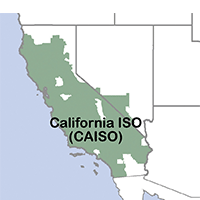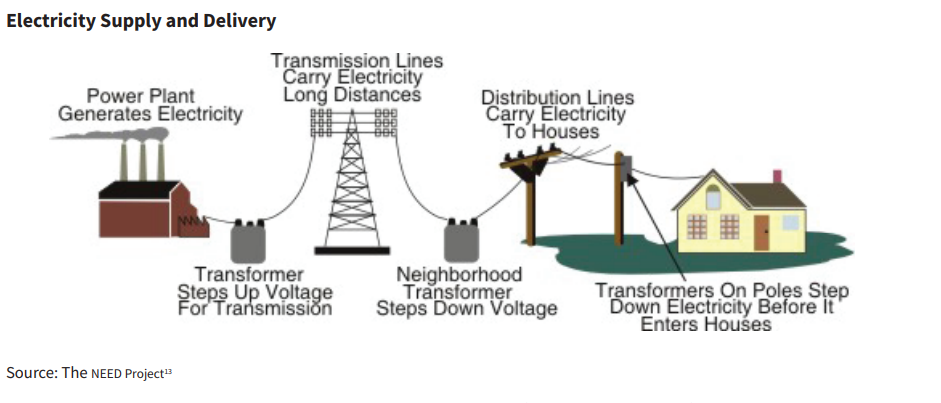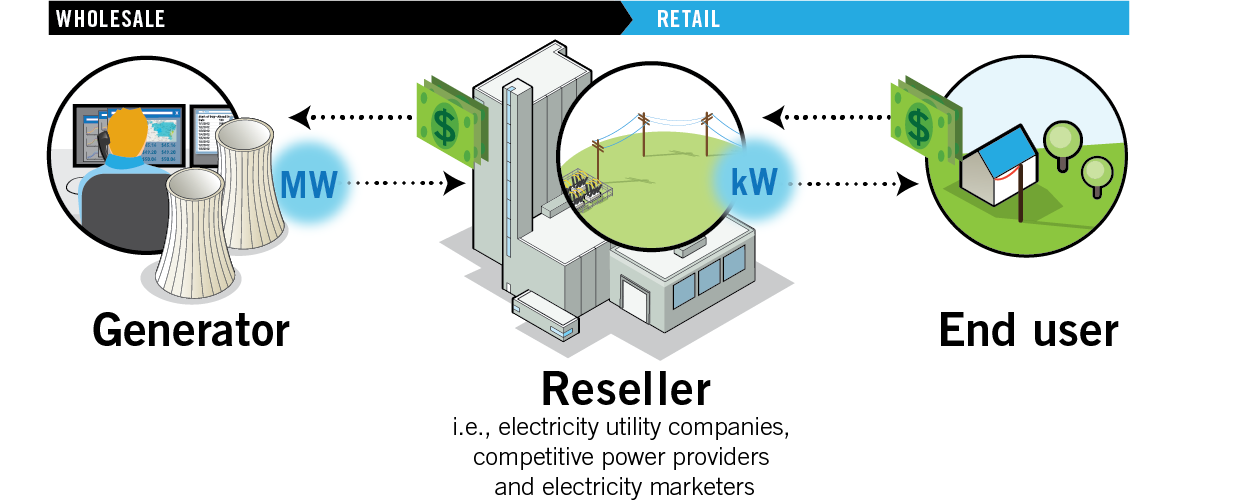Q. What is CAISO and what does it do?
A. CAISO, headquartered in Folsom, California, is the independent system operator (ISO) of the California wholesale electric grid. As such, it manages the flow of electricity across the high-voltage, long-distance power lines for the electric grid serving 80 percent of California and a small part of Nevada.[1] Below is a recent map. This means that CAISO operates the wholesale electricity transmission system in the area shown and develops rules to manage such transmission reliably, safely, and equitably. CAISO has also developed various markets, including electric energy markets, in which buyers and sellers bid to purchase or offer to sell wholesale electricity. CAISO is one of seven ISOs or regional transmission organizations (RTOs, collectively with ISOs referred to as ISO/RTOs) operating in the U.S. The Federal Energy Regulatory Commission (FERC) has regulatory oversight as to the activities of CAISO.
In the late twentieth century and the early part of this century, FERC sought to develop organized markets for wholesale electricity sales so that sellers and buyers would be able to connect with ease and efficiency and achieve competitive, fair, market-based prices based on supply and demand. CAISO continues to run these wholesale electricity markets in its territory, which are an intricate operation involving development and adjustment of very complex market rules, based on input from stakeholders and rulings by FERC.
Q. What does it mean when you say that CAISO operates the “wholesale electricity transmission system” for much of California?
A. The “transmission” of electricity that CAISO operates in its territory is generally that which is carried over high-voltage transmission lines, often at significant distances. Local distribution of electricity, such as the electricity that runs through a neighborhood on electric utility poles to serve retail customers, is considered to be “distribution,” not “transmission,” and is generally a matter of state or local regulation. One key distinction between transmission and distribution is voltage, which can be described as the difference in “pressure” that pushes electricity from one point to another. The North American Electric Reliability Corporation (NERC), which FERC has designated as the entity responsible for establishing and enforcing reliability standards for the “bulk power system,” generally uses 100 kilovolts (kV, equivalent to 100,000 volts) as the minimum threshold for transmission lines, while distribution lines often operate at lower voltages. The bulk power system refers to the generating resources and high-voltage transmission equipment that make up the electric system networks and components that generate and deliver electricity to customers across North America.
The following diagram illustrates the path electricity travels, including CAISO’s operation of transmission lines subject to FERC’s jurisdiction[2]:
You have probably seen tall poles carrying electricity along a strip of land that look like the tall metallic pole in the middle of the above picture; this is an example of electricity transmission.
Q. Does CAISO own the electric transmission that it operates?
A. No. Utilities own the transmission infrastructure (lines and poles and other equipment) and cede operational control over it to CAISO. CAISO is called an “independent system operator” or “ISO” because it has independent authority, overseen by FERC, to operate the transmission lines owned by the utilities. Many of the major utilities in California, including Pacific Gas & Electric, San Diego Gas & Electric, and Southern California Edison, have chosen to become what are called “participating transmission owners” in CAISO,[3] meaning that they have given operational control of the transmission facilities that they build and own to CAISO. In return, such utilities receive “just and reasonable rates” through CAISO when those facilities are used, with the payments coming from the users or allocated in accordance with CAISO rules.
Q. What does “wholesale electricity” mean, and why does CAISO operate a market for it?
A. To understand wholesales sales of electricity, consider the graphic below[4]: In the graphic, the power generation plant (Generator) sells electricity to an electric utility or other company that resells power (Reseller), who in turn intends to resell that electricity to homes and businesses (End User). The sale from Generator to Reseller is a wholesale sale of electricity and FERC would have jurisdiction over the rates charged in such sale, so long as the sale is in interstate commerce. Wholesale sales in CAISO territory are in interstate commerce because California is part of an interconnected grid with neighboring states.
Wholesale sales of electricity can be contrasted with “retail” sales of electricity to end-users. When your local electric utility sells you electricity for use in your home or business, that is a retail sale, not wholesale, and is not under the jurisdiction of FERC. Oversight of retail electric rates and service in California is performed by the California Public Utilities Commission (“California PUC”)[5] or by your municipal or local electric company or cooperative, such as East Bay Municipal Utility District, Los Angeles Department of Water and Power, or Sacramento Municipal Utility District. If you have concerns about your retail electric bill or service, you should address those with the California PUC, the applicable local regulatory authority, or your utility, not CAISO or FERC.
Q. Why are CAISO processes and markets important?
A. Although CAISO is not directly involved with your electric bill or the electric service to your home or business (as noted above, those tasks are met by your utility), CAISO decisions have a major impact on the price and reliability of electricity in California as well as on the implementation of key policies, including renewable energy goals and reducing power plant emissions.
For example, it is CAISO’s responsibility to balance demand for electricity with the available supply through operation of its wholesale electricity market. Electric grids must run in balance, i.e., the electricity coming onto the grid must equal the electricity being used. Battery storage technologies are increasingly being used to help the grid to remain balanced by injecting generation when needed, but CAISO continues to bear responsibility to balance its grid and carefully manage challenging operational issues.
Every five minutes, CAISO forecasts electric demand and dispatches the lowest cost set of power resources that bid into the market to provide electricity to meet demand, considering factors such as the capacity of the transmission wires, power plant disruptions or outages, and natural disasters and extreme weather conditions. CAISO also conducts day-ahead forecasting of demand for electricity, and there are thus two energy markets: a “real-time” energy market that is dispatching energy resources and allocating payments to meet immediate needs, and also a “day-ahead” energy market that accepts next-day electricity bids from market participants in order to meet anticipated demand with some advance planning. Load serving entities like utilities seek to meet most of their needs through the CAISO day-ahead energy market to reduce their pricing risks.
The day-ahead market allows CAISO to take into account transmission congestion that may arise from prevailing conditions, especially weather. Congestion is when a portion of the transmission grid becomes overloaded with electric power. Such overloading can cause a wire to retain heat, stretch and, in an extreme case, come in physical contact with other wires, structures, or vegetation, which creates a hazard. To avoid such consequences and threats, CAISO forecasts demand and designs its market rules to choose the lowest-cost resources consistent with any anticipated congestion constraints on the transmission system. This might mean that a power plant or other supply resource located close to a demand center (for example, a large town or city) could be called upon to produce electricity on a certain day even if it is not the lowest-cost resource.
Note that instead of or in addition to bids from a power plant to supply electricity, at least part of California’s needs may be satisfied through bids from (typically large) customers offering to reduce their power usage, such as a big-box store offering to reduce air conditioning use at key times. These are called “demand response” bids into the CAISO electric energy market. Such demand response bids can have a major impact on electricity pricing and can reduce overall emissions from the generation of electricity, but the rules for participation in the market as demand response are quite complex.
CAISO has other specialized products and services that it procures to ensure adequate electric capacity, sufficient voltage to enable the grid to operate, and other technical goals.
Q. How is CAISO governed?
A. The CAISO Board of Governors (Board) is the primary approval body on matters related to CAISO.[6] The CAISO Board consists of five members who serve three-year terms. The terms are staggered to avoid complete turnover on one date. When a vacancy arises, CAISO hires an executive search firm to identify candidates and recommends candidates for the Board to the Governor of California. The Governor, with the approval of the state senate, selects the new board member.
The CAISO Board reaches decisions based on a majority vote of its five members.
Q. How do people interested in CAISO issues participate? How are new issues raised? How does one file a comment on an issue under consideration? How can one stay informed as to CAISO meetings, events, and activities?
A. Unlike other ISOs/RTOs, CAISO does not have a committee structure for consideration of issues and changes to market rules. Other ISOs/RTOs also have stakeholder voting schemes, so that stakeholders can weigh in on proposed market rule changes (although such votes are not necessarily binding). CAISO has no stakeholder voting. Instead, CAISO opens “stakeholder initiatives” on a range of market-related and transmission-related issues and policy initiatives and schedules regular meetings to discuss those initiatives. These meetings are open to the public, although some documents may be confidential for security or legal reasons, and follow the CAISO “Open Meeting Policy” governing quorums, notices, agendas, allowance for recording by audio and video, and other topics.[7] One example of a relevant provision in the Open Meeting Policy is that if the Board votes to recess an open meeting to another time and place, the reconvened meeting can only conduct the business previously noticed for the recessed meeting. The overall goal of the Open Meeting Policy is to “afford[] the public the greatest possible access consistent with other duties of the corporation” and the Policy is designed to be compliant with State of California open meeting laws.
Any person may participate and offer public comment during a CAISO Board meeting. In addition, any person may (i) submit an issue to CAISO for review, and (ii) provide comments on straw proposals and policy papers that are developed by CAISO staff prior to their formal presentation to the CAISO Board.
CAISO’s website has a page with links to its meetings and events, board and committee activities, stakeholder input processes, and similar information.[8] There is a page where one can sign up for subscriptions and notifications.[9] A master calendar of CAISO events and meetings is also available.[10] There is also a link for stakeholder initiatives and information, called the “stakeholder center,” that includes a commenting tool and a chart of various issues and their stage in the decision-making process.[11]
Here is an excerpt of the chart in the stakeholder center link, showing issues and timelines. You can see the issues for which there have been decisions, upcoming meetings, background, and other information:
Here is a picture of the “commenting tool” button at the stakeholder center website as well as a place to click for more info about recent policy initiatives:
Q. How can a person interested in CAISO matters impact CAISO decision-making processes?
A. As discussed above, CAISO and its Board provide opportunities for direct participation by the public in meetings and to suggest issues for further study.
As with all ISO/RTOs, the issues that the CAISO Board resolves and rules upon are ordinarily quite complex and detailed, written in technical language, and in some cases reflect over twenty years of history and negotiation. Many active stakeholders in ISO/RTO processes, such as those in CAISO, study electric market, reliability, and technology issues at length and have been involved for many years in these issues and CAISO processes (along with state and federal energy proceedings). Thus, it could be challenging for any individual member of the public, without considerable effort, to feel like they have made a real difference in a CAISO Board decision process. The learning curve is steep because of the long history of many issues and the unique technical language, acronyms, and rule references.
Members of the public and communities who have a keen interest in CAISO proceedings generally or on a certain issue before CAISO should therefore consider aligning themselves with active CAISO stakeholders with similar views that have the resources to track, attend, interpret, and comment on CAISO processes on a frequent basis. Whatever your interests are, you are very likely to find that there are stakeholders that are already participating actively and would appreciate your input and support. Such active stakeholder allies may also be able to help you to navigate the CAISO processes and learn how to channel your thoughts, concerns, experiences, and energy toward achievable results.
Q. How do I learn more about CAISO?
A. The CAISO website (footnote 1) is an excellent first place to start. FERC also has resources that can help you gain more background on the electric industry generally, with some specifics on CAISO, in its 2020 Energy Primer.[12] If you would like more information about CAISO, please contact the Office of Public Participation (OPP) for information as well as help with navigating FERC’s web resources. OPP may be reached by e-mail at [email protected] or by phone at (202) 502-6595.
[2] Graphic developed by the National Energy Education Development Project, Electricity, at 56 (2017), http://www.need.org/Files/curriculum/infobook/Elec1S.pdf.
[3] A list of Participating Transmission Owners in CAISO can be found here: https://www.caiso.com/Documents/ListParticipatingTransmissionOwners.pdf. Note that the Participating Transmission Owners are also sometimes referred to as “Transmission Owners” or “TOs,” including when they make filings at FERC.
[4] From learn.pjm.com
[6] See “Governance Structure and Practices in the FERC-Jurisdictional ISOs/RTOS,” prepared by Exeter Associates, Inc. for NESCOE, located at http://nescoe.com/wp-content/uploads/2021/02/ISO-RTOGovernanceStructureandPractices_19Feb2021.pdf
[7] Here is a link to a recent version of the Open Meeting Policy: http://www.caiso.com/Documents/CaliforniaISOOpenMeetingPolicy.pdf





